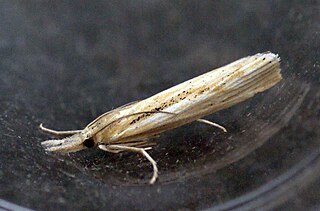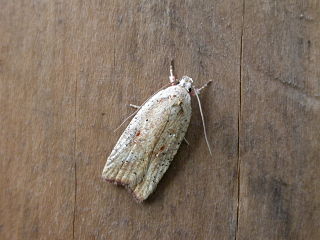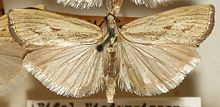
Ephestia elutella, the cacao moth, tobacco moth or warehouse moth, is a small moth of the family Pyralidae. It is probably native to Europe, but has been transported widely, even to Australia. A subspecies is E. e. pterogrisella.

Enarmonia formosana, the cherrybark tortrix or cherry-bark moth, is a small but colorful moth species of the family Tortricidae. It is native to all of northern and western Europe, ranging south to the Maghreb. North of the Alps its range extends eastwards to Siberia and Kazakhstan. Possibly and most likely introduced populations are found in Asia Minor and North America, respectively.

The Viper's Bugloss(Hadena irregularis) is a species of moth of the family Noctuidae. It is found in Europe.

Agriphila geniculea, the elbow-striped grass-veneer, is a species of moth of the family Crambidae. It was first described by Adrian Hardy Haworth in 1811.

Agriphila latistria is a species of moth of the family Crambidae. It is found in Europe, but originates from the area surrounding the Mediterranean Sea.

Agriphila straminella is a species of moth of the family Crambidae. It was described by Michael Denis and Ignaz Schiffermüller in 1775 and is found in Europe and east across the Palearctic.

Agriphila tristella, the common grass-veneer, is a species of moth of the family Crambidae found in Europe and Asia.

Agriphila selasella is a species of moth of the family Crambidae. It was described by Jacob Hübner in 1813 and is found in Europe and east across the Palearctic.

Pediasia aridella is a species of moth of the family Crambidae. It was described by Carl Peter Thunberg in 1788 and is found in Europe. There are three recognised subspecies.

Borkhausenia minutella is a species of moth. Within its superfamily, it is placed within the subfamily Oecophorinae of the "concealer moth" family, Oecophoridae.

The gorse tip moth is a smallish moth species of the family Depressariidae.

Agrotis trux, the crescent dart, is a moth of the family Noctuidae. The species was first described by Jacob Hübner in 1824. It has a circum-Mediterranean distribution and is found along the coasts of France, Ireland, England, southern Europe, Algeria, Syria, Iraq, Iran, southern Russia and the Arabian Peninsula. In Africa, it is found as far south as South Africa.

Celypha aurofasciana is a small moth species of the family Tortricidae. It is native to Europe and the Palearctic but occurs in some other places as an introduced species.

Sabatinca doroxena is a species of moth belonging to the family Micropterigidae. It is endemic to the North Island of New Zealand. This small moth has a colourful forewing pattern with stripes and dots evident. It has been hypothesised that the forewing pattern is intended to resemble a jumping spider in order to allow the adult moth to escape predation. Adults of this species are on the wing from the beginning of September until mid January. It prefers damp but sunny habitat in deep forest, at the forest edge or in open shrubland. Larvae feed on foliose liverwort species including on Leptoscyphus normalis. Adults of this species have been located at the blossoms of flowering Cordyline and Ranunculus species.

Cochylis hybridella is a moth species of the family Tortricidae. It is found in most of Europe, the Near East, China, Japan, Korea and Russia.

Hypsopygia glaucinalis is a moth of the family Pyralidae. It is sometimes placed in the genus Orthopygia either alone or with a few other species. Being the type species of Orthopygia, as soon as O. glaucinalis is placed in Ocrasa"Orthopygia" is abolished. To further complicate matters, Ocrasa is now mostly treated as a synonym or subgenus of Hypsopygia.

Ichneutica arotis is a moth of the family Noctuidae. It is endemic to New Zealand. This species is found throughout the North and South Islands but has yet to be recorded on Stewart Island. I. arotis is variable in appearance and have been described as having a "northern dark form", a "typical" form and a "swamp" form. Robert Hoare hypothesised that this species may be in the process of evolving into several distinct species. However, as these forms show no difference in antennae or genitalia so, as at 2019, they are not regarded as separate species. Larval hosts include species in the genera Cortaderia and Schoenus as well as Phormium tenax. The caterpillar feeds at night and rests in during the day amongst dead flax leaves. It pupates in a loose cocoon either hidden at the base of a stem of flax or on the ground. The adults of this species is on the wing from September to April. In the North Island there have also been records of adults being on the wing in June to August.

Erechthias hemiclistra is a species of moth of the family Tineidae. It was first described by Edward Meyrick in 1911. This species is endemic to New Zealand and has been observed in both the North and South Islands. It inhabits native forest and has an affinity for species in the genera Phormium,Cortaderia and Cordyline, likely as a result of its larvae feeding on dead fibre sourced from plant species in these genera. Adults are on the wing from September to April but are most commonly observed in December and January. Adults are also attracted to light.
Cryptaspasma brachyptycha is a moth of the family Tortricidae first described by Edward Meyrick in 1911. It is found in Sri Lanka and Australia.

Ichneutica paracausta is a moth of the family Noctuidae. This species is endemic to New Zealand. It is found locally in the central North Island, is widespread in the South Island and can also be found in Stewart Island. I. paracausta is variable in colour, but as it has a distinctive black streak on its forewing as well as a wing pattern that is characteristic, I. paracausta is unlikely to be confused with other species. It is present on the North Island volcanic plateau as well as Little Bush Reserve in Hawkes Bay in the North Island as well as in tussock grassland, alpine and subalpine shrubland and in alpine forest. Larvae have been recorded as feeding on grasses, a pupa has been found in a cocoon under the bark of a tree and adult moths are on the wing from October to January.




















